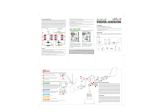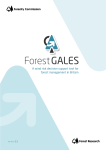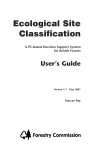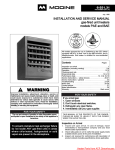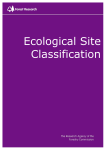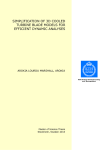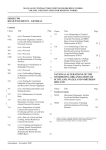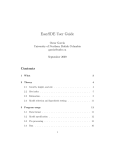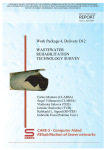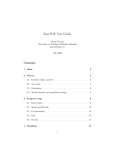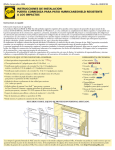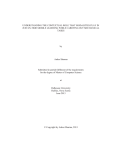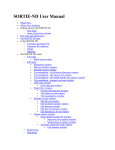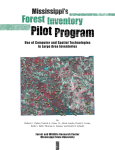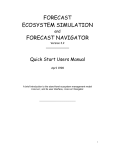Download ForestGALES User Manual
Transcript
ForestGALES A PC-based wind risk model for British Forests User’s Guide Version 2.0 June 2004 Barry Gardiner, Juan Suárez, Alexis Achim, Sophie Hale and Bruce Nicoll © Crown Copyright 2004 ISBN: 0 85538 632 0 Produced in the United Kingdom FCSW001/FG(KMA)/AST&AM-200/JUN04 Licence Agreement This licence agreement applies to ForestGALES version 2.0 You should carefully read the following terms and conditions before using this software. Your use of this software indicates your acceptance of this licence agreement and warranty. You shall not alter, modify or reverse engineer the original software or give anyone else permission to do so. Unregistered use of ForestGALES after the beta-testing evaluation period will be in violation of UK and international copyright laws. Disclaimer of Warranty THIS SOFTWARE AND THE ACCOMPANYING FILES ARE DISTRIBUTED ‘AS IS’ AND WITHOUT WARRANTIES AS TO PERFORMANCE OR MERCHANTABILITY OR ANY OTHER WARRANTIES WHETHER EXPRESSED OR IMPLIED. In particular, there is no warranty for the predictions made by the model as they are regarded as indicative and not prescriptive. NO RESPONSIBILITY FOR LOSS OCCASIONED TO ANY PERSON OR ORGANISATION ACTING, OR REFRAINING FROM ACTION, AS A RESULT OF ANY MATERIAL IN THIS PRODUCT CAN BE ACCEPTED BY THE FORESTRY COMMISSION. ForestGALES is a PC-based program that has been designed to work under all Microsoft Windows Operating Systems. Because of the various hardware environments into which ForestGALES may be put, NO WARRANTY OF FITNESS FOR A PARTICULAR PURPOSE IS OFFERED. The installation disks have been thoroughly tested for computer viruses with the latest virus checking technologies available at the Forestry Commission. However, the user must assume the entire risk of using the ForestGALES program and therefore nobody apart from the user will be responsible for the loss of critical data or any other damage to the systems as a result of virus attack or a malfunction of the program. Trademarks All terms mentioned in this book that are known to be trademarks or service marks have been appropriately indicated. The Forestry Commission cannot attest to the accuracy of this information. Use of a term in this book should not be regarded as affecting the validity of any trademark or service mark. Readers should contact the appropriate companies for more complete information regarding trademarks and registration. Forest GALES version 2.0 Contents Preface v 1. Introduction Why use ForestGALES? The degree of constraint posed by strong winds in Britain Historical context – Previous predictive windthrow model What does ForestGALES calculate? How does ForestGALES compare to the WHC? What is new in ForestGALES 2.0 Wind climate Appearance Defaults Multiple stands (batch) mode Export 1.1 1.1 1.1 1.1 1.2 1.2 1.3 1.3 1.3 1.3 1.3 1.4 2. Installing and uninstalling System requirements Installing ForestGALES Uninstalling ForestGALES Running the model for the first time 2.1 2.1 2.1 2.2 2.3 3. How the model works How does the model work? What force would be needed to uproot or break the tree? What wind speed would create the force required to damage the tree? What is the probability of a damaging wind speed occurring? 3.1 3.1 3.1 3.1 3.2 4. Using ForestGALES Running ForestGALES Operating modes Selecting a mode and opening a query form ForestGALES query forms Navigating ForestGALES Using the mouse to make selections Using the Tab key Using shortcuts Getting help 4.1 4.1 4.1 4.1 4.1 4.3 4.3 4.3 4.4 4.4 5. Predictions using field measurements Introduction The stand characteristics box Options – Stand ID Options – Cultivation Options – Drainage Options – Soil type Options – Current spacing Options – Current stocking The tree characteristics box Options – Species Options – Top height Options – DBH The DAMS box Grid references method Exact calculation method Rough guess method The upwind edge effect box 5.1 5.1 5.1 5.1 5.1 5.2 5.2 5.2 5.2 5.3 5.3 5.3 5.4 5.4 5.4 5.4 5.5 5.5 version 2.0 Forest GALES Contents The controls box The wind damage risk box Critical wind speed Return period Wind damage risk status Windthrow Hazard Classification (WHC) 5.6 5.6 5.6 5.6 5.7 5.7 6. Predictions using yield models Introduction Stand characteristics box Options – Planting year Tree characteristics box Options – Yield class Options – Thinning regime Options – Initial spacing Options – Age The ‘Tree Details’ button Other boxes User defined yield tables Overview Naming user defined yield models Using Excel® to create user defined yield models 6.1 6.1 6.1 6.1 6.2 6.2 6.2 6.2 6.2 6.2 6.2 6.3 6.3 6.3 6.4 7. Predictions through time Introduction Stand characteristics box Tree characteristics box The DAMS box The controls box User-defined yield tables Viewing the results The graphics window The tabular data windows The results form control box 7.1 7.1 7.1 7.1 7.1 7.1 7.1 7.2 7.2 7.3 7.3 8. Multiple stands Introduction The multiple stands helper The controls box The multiple stands query form The controls box Year of calculation 8.1 8.1 8.2 8.3 8.3 8.4 8.4 9. Examples 9.1 Single stand predictions using field measurements – getting started 9.1 Single stand predictions using field measurements – the effect of a new edge 9.1 Single stand predictions using yield models 9.2 DAMS example 9.3 DAMS – rough guess example 9.4 DAMS – grid reference example 9.4 DAMS – calculate DAMS example 9.5 10. Glossary 10.1 11. References & further reading 11.1 Forest GALES version 2.0 Preface Welcome to ForestGALES Acknowledgements The initial development of ForestGALES was funded by the Forestry Commission, and in part by the European Union as part of the STORMS project. Continued improvement has been supported by the Forestry Commission Forestry Group. We are grateful to the many users of ForestGALES who have provided valuable feedback and comments on the previous version. We would also like to thank all those who tested the Beta version of this software. Colleagues within the Forestry Commission who have contributed to the development include Bill Rayner, Bill Mason, Colin Edwards, Elaine Dick, Kirstie Adamson, Duncan Ray, Shaun Mochan and Chris Quine. We would like to thank all those who have helped make this project a success. Credits Stability project team: Barry Gardiner, Bruce Nicoll, Juan Suárez, Alexis Achim, Sophie Hale, Elspeth Macdonald and Bill Rayner : Software development: Juan Suárez, Barry Gardiner, Roger Dunham, Juergen Bohl and Mark Brady Testing and validation: Juan Suárez, Juile Barrette and Sophie Hale Manual: Barry Gardiner, Juan Suárez, Alexis Achim, Sophie Hale and Bruce Nicoll. For details of latest updates and on-line version of this manual access www.forestry.gov.uk/forestgales For help and assistance contact: Barry Gardiner Forest Research Northern Research Station Roslin Midlothian EH25 9SY United Kingdom Phone: Fax: + 44 131 445 2176 + 44 131 445 5124 E-mail: [email protected] version 2.0 Forest GALES Forest GALES version 2.0 Introduction Why use ForestGALES? Wind damage to forest stands results in both direct costs (additional cost of harvesting) and indirect costs (loss of amenity, danger). Threat of wind 1 damage has restricted silviculture and led to the use of truncated rotations with precautionary felling in anticipation of windthrow. Forest managers therefore require guidance on the timing and magnitude of wind damage. A number of risk-minimising strategies can be applied (see Quine et al., 1995) but these may be costly and so are best carried out only where the risk is high. The strategies can involve operations within individual stands (typically 1–20 ha), or the layout of stands at the forest scale (areas up to 50 000 ha). A sound choice between techniques which may influence the risk of damage such as type of cultivation, thinning, sequence of felling, is most likely where prediction of their effects is possible. Research into both prevention and prediction of damage has been carried out for nearly 30 years and this past work has been drawn together to provide ForestGALES as a tool to guide forest managers. The degree of constraint posed by strong winds in Britain Wind damage is a serious problem in forests planted on exposed sites in Britain and western Europe. It is believed to cost the countries of the EU more than € 15 million per year, and in extreme cases substantially more. Five ‘catastrophic’ storms have affected British forests in the 50 years since 1945, emphasising the frequency and scale of the problem – these include the storms of 1998 in south Scotland, 1990 in south-west England and south Wales, 1987 in the south-east of England, 1968 in the central belt of Scotland, and 1953 in north-east Scotland. In each case over 1 million cubic metres of timber was damaged, and up to five times the normal annual cut for the affected region required harvesting. In 1999, storms Lothar and Martin damaged more than 190 million cubic meters of timber in continental Europe. Lesser storms also cause some wind damage in most years, and their combined effect is a serious constraint in upland forests. Windthrow has been the main form of damage, but wind snap can be locally important when trees are particularly well anchored or the crowns are loaded with wet snow. Historical context – previous predictive windthrow model Until recently choices of windthrow-minimising strategies were guided by the windthrow hazard classification ((WHC): Miller, 1985) which provided a method to zone forest areas of 500 ha or more by adding scores for windiness and soil together to estimate a hazard class. Each class was associated with a critical and a terminal height (see Table 1.1) which respectively indicated the heights at which damage was expected to start and to reach a level necessitating clearance. The WHC provided a successful basis for comparing sites and guiding decisions on thinning, but did not predict the timing or amount of damage with acceptable accuracy (Quine and Bell, 1998). It was based on subjective weighting of the influence of strength of wind and inadequacy of version 2.0 Forest GALES 1.1 Introduction rooting on the timing of wind damage. While this synthesised understanding in the 1970s it could not be readily updated to incorporate new knowledge. Research since the WHC was devised has improved understanding of root anchorage (Coutts, 1983; Coutts, 1986), turbulence (Gardiner et al., 1997), adaptive growth (Nicoll and Ray, 1996), and wind climate (Suárez et al., 1999). While it was possible to incorporate such advances in qualitative advice (Quine et al., 1995) a new system was needed to treat wind risk quantitatively. Table 1.1 Critical and Terminal heights for each of the six classes defined by the Wind Hazard Classification. WHC class 1 Critical height (m) Non-thin Selective Terminal height (m) Line thin Unconstrained by windthrow Non-thin Selective Line thin Unconstrained by windthrow 2 25.0 22.0 21.0 31.0 28.0 28.0 3 22.0 19.0 17.0 27.0 25.0 23.5 4 19.0 16.0 14.0 24.0 21.5 18.5 5 16.0 13.0 12.0 19.5 17.5 15.5 6 13.0 10.0 9.0 15.5 13.5 11.5 What does ForestGALES calculate? ForestGALES calculates the probability of average trees being damaged within a stand. Damage to the average tree will by implication mean that the stand as a whole will be substantially damaged. How does ForestGALES compare to the WHC? ForestGALES estimates the chance (or probability) of windthrow or stem breakage, rather than stating a precise height at which damage will occur as in the WHC. Probabilistic predictions are more realistic than precise heights since the occurrence of damaging winds varies from year to year, which has a powerful influence on the occurrence and spread of damage. The risk of damage is extremely dependent on the windiness of the site. In the WHC the measure of windiness is much coarser than is used in ForestGALES. This allows ForestGALES to discriminate several levels of risk for trees in similar WHC classes. For example, a crown thinned stand of YC 12 Sitka spruce planted on a deep ploughed gley soil, with average drainage, where the DAMS score is 14, will have a critical height of 19.0 m and a terminal height of 21.5 m. The standard Forestry Commission yield models (Edwards and Christie, 1981) indicate that the trees will reach 21.4 m top height at age 51 when the return period for damage will be 7 years. On the other hand if the DAMS score is 10, then the site will still have a WHC class of 4, yet the return period for damage to a 51-year-old stand has increased to 200 years. 1.2 Forest GALES version 2.0 Introduction What is new in ForestGALES 2.0 ForestGALES 2.0 represents a complete rewrite of the ForestGALES software. The new software is a much more efficient and robust code, which is easier to understand and to document. Furthermore, it allows much easier integration with other modelling tools. The main part of ForestGALES (the part that does the actual calculations) has been constructed as a stand-alone dynamic link library (DLL). This means that all the functionality of ForestGALES is available from any other programme. The creation of a DLL has made it much easier for ForestGALES to be integrated with GIS software such as ArcView. Currently trials are under way in a forest district on the use of ForestGALES within ArcView. Following these trials a general release of a ForestGALES add-on to ArcView will be made available. Wind Climate The most important change to the calculation of risk is the change to the wind climate calculator. The calculation of the probability of a particular wind speed occurring at a site is based on the DAMS score. Additional analysis of wind climate data from Forest Research wind monitoring areas has suggested that the wind climate calculator was pessimistic. The differences are most pronounced at low DAMS scores but even at a DAMS value of 15 the new regression has the effect of reducing the DAMS score by 2 to an effective score of 13. This is the only change in the calculation of risk. Critical wind speeds remain identical to ForestGALES 1.3 but the probability of these wind speeds occurring is reduced. Appearance The appearance of ForestGALES has been improved to provide a more consistent view and to provide for easier operation. Defaults There is now a Defaults button (Alt + D) that can be used to store the current values as the default. Therefore, if the current soil is a brown earth and the Defaults button is pressed then brown earth becomes the default soil used in ForestGALES. This is particularly useful if one is consistently working with a particular combination of species, cultivation and soil types. Multiple Stands (Batch) Mode The Batch operations have been substantially improved. Entering data in Multiple Stands Mode now uses the same forms as for Single Stand data entry and there are three versions of Multiple Stands Mode matching the three methods of calculating risk (Predictions using field measurements, Predictions using yield models, Predictions through time). Unlike the previous version of ForestGALES it is now possible to use the yield models to enter data or to calculate risk through time when in Multiple Stands Mode. In all cases input data and results can be stored in files for later use. version 2.0 Forest GALES 1.3 Introduction Export There are improved export facilities in ForestGALES 2.0 allowing results to be sent to Word® as a Doc or Rtf file in the Single Stand mode and to Excel® in Multiple Stands Mode for display, storage and printing. 1.4 Forest GALES version 2.0 Installing and Uninstalling System requirements ForestGALES will run on IBM compatible personal computers that have a minimum of: 2 • Microsoft Windows operating system • Pentium 133 megahertz (MHz) or higher processor • 32 Mb of RAM • CD-ROM drive • 20 Mb of hard disk space if DAMS scores left on CD (520 Mb for full installation) • Super VGA (800 x 600) display or higher-resolution monitor with 256 colours Recommended: Microsoft Excel/Word 97® or above to use data export facilities Installing ForestGALES To install ForestGALES: 1. Place the ForestGALES CD in the CD drive. 2. The program will automatically install. If automatic installation does not occur, then: 3. Press the Start button. 4. Press Run. 5. Type D:\Setup.exe into the dialog box, which will appear (replace the letter D with whatever drive letter corresponds to your CD-ROM drive). 6. Left click on OK. By default the program will then be installed into the directory C:\Program Files\Forest Research\ForestGALES_ver2 on the drive, although it may be placed elsewhere if required. The installation program will automatically place all the files where they are needed, and add an option to run ForestGALES 2.0 from the Programs bar. version 2.0 Forest GALES 2.1 Installing and Uninstalling Uninstalling ForestGALES To uninstall the program: 1. Press Start. 2. Choose Settings. 3. Choose Control Panel. 4. Choose Add/Remove Programs then select ForestGALES 2.0 from the list of programs. 5. Left click on Add/Remove. This will remove all the components and data files of ForestGALES 2.0, with the exception of files created while using the program. Exceptions include saved/exported data files and new yield models. 2.2 Forest GALES version 2.0 Installing and Uninstalling Running the model for the first time Start the program from the Windows Start. After the initial welcome screen you will be presented with the main menu window as shown in Figure 2.1. Choose Mode, Single stand, Prediction using field measurements and a new query form will appear as shown in Figure 2.2. Set: – Species to ‘Sitka spruce’ – Cultivation to ‘notched planting’ – Drainage to ‘Average’ – Soil to ‘Peaty Gley’ – Current spacing to 2.6 m – Top Height to 18 m – DBH to 19 cm – DAMS score of 15 Press the Run button and the Return Period, Wind Damage Risk Status and Critical Wind Speeds for overturning and breakage will appear in the previously empty boxes at the bottom of the form. Return periods will be 200 years for both overturning and breakage. Change the top height to 19 m using the up arrow next to the top height edit box and press the Run button again. The return periods will change to 53 years for breakage but remain 200 years for overturning. You are running ForestGALES! The various options available for the model are explained in later sections of this manual. Figure 2.1 The ForestGALES main menu. version 2.0 Forest GALES 2.3 Installing and Uninstalling Figure 2.2 Query form for Single stand predictions using field measurements. 2.4 Forest GALES version 2.0 How the Model Works How does the model work? The model uses data relating to individual trees to estimate the risk of damage to stands of trees by answering three questions: 3 1. What force would be needed to uproot or break the tree? 2. What wind speed would create the force required to damage the tree (i.e. what is the threshold or critical wind speed)? 3. What is the probability of the threshold wind speed being exceeded? What force would be needed to uproot or break the tree? The model calculates the strength of the stem and the resistance of the tree to overturning independently. Stem strength is based on theoretical work regarding tree stems as structures, and a knowledge of the wood strength and stiffness of different tree species. Resistance to overturning is based on an extensive database of tree pulling experiments that relate tree characteristics to the load required to pull a tree over. These experiments have been conducted on a range of soil and cultivation types for many species. However in some circumstances no data are available, so assumptions have been made to allow data to be extrapolated. When this happens, a warning message box will appear and the results should be used with caution. The effect of drainage intensity is included in the calculation based on the average change in force needed to pull over trees on well or poorly drained soils in comparison to soils with ‘average’ drainage. What wind speed would create the force required to damage the tree? In ForestGALES the wind loading on trees is calculated from the drag the forest exerts on the flow above the canopy. The drag is a function of the wind speed and the aerodynamic roughness of the canopy which is dependent on the crown size and the area of ground occupied by each tree. Crown size is modelled using regressions based on the height and diameter of the tree. From a knowledge of the average wind loading on each tree and the resistance to breakage and overturning, the wind speed that would just cause the tree to overturn or break is calculated. This includes calculating the extra force due to the overhanging weight of the crown and stem as the tree bends. version 2.0 Forest GALES 3.1 How the Model Works What is the probability of a damaging wind speed occurring? Having calculated the wind speed required to damage the tree, the probability of such a wind speed is estimated. The average windiness of the site is measured using the DAMS system, which is based on location, elevation and exposure. However, average winds are unlikely to damage the tree, and the risk of extreme winds that are sufficiently strong to cause damage must be derived from DAMS using a Weibull distribution. This distribution is extremely sensitive, and small changes in the wind speed required to cause damage can be associated with large changes in the probability of damage occurring. Having calculated the probability of damage, this is converted to a return period for a damaging wind speed occurring. This is the average interval between storms that are associated with damaging winds. Wind Damage Risk Status provides a rough estimate of risk, ranging from Status 1 (return period for damaging winds more than 100 years) to Status 6 (return period less than 10 years). 3.2 Forest GALES version 2.0 Using ForestGALES 4 Running ForestGALES There are several ways to start the program. The easiest is to press Start, followed by Programs, ForestGALES 2.0, ForestGALES. When this is done, the program will start and the main menu (Figure 2.1) will load onto the screen. ForestGALES has been designed as a complete Windows application. Menus are easily accessible with the mouse in the top part of the main window, or they can be accessed using pop-up windows, shortcut keys or speed buttons. Operating modes ForestGALES can be used interactively in two operating modes: Single stand mode - calculates the risk for one particular stand. Multiple stand mode - calculates the risk for a number of stands one after another (batch mode). There are three ways of making predictions within these modes: Predictions using field measurements - calculates the risk of damage at a single point in time from stand characteristics defined by the user. Predictions using yield models - calculates the risk of damage at a single point in time from stand characteristics contained in yield models. Predictions through time - calculates the risk of damage over a typical rotation from stand characteristics contained in yield models. Selecting a mode and opening a query form Having started the program, to select a particular mode, left click on Mode at the top of the main menu. A menu will appear. Left click on the mode that you want, and the menu will disappear, and a form will appear automatically. Alternatively, a new form can be created using the shortcut buttons at the top of the main window. The meaning of each shortcut button is indicated by a hint message that appears when the mouse is positioned over the button. It is possible to have several copies of a query form open at the same time. This may be useful if you wish to compare alternative scenarios. ForestGALES query forms ForestGALES collects data from and writes results to query forms. The exact layout of the form depends on the mode (single stand, multiple stands) in which the model is being used and the type of prediction being made (using version 2.0 Forest GALES 4.1 Using ForestGALES field measurements, using yield models, through time). Figure 4.1 shows the layout of the form for Single stand predictions using field measurements. Figure 4.1. Query form for Single stand predictions using field measurements. The parts of this form are: Stand characteristics box Tree characteristics box Controls box DAMS box Edge effect box Wind damage risk box Stand characteristics box – describes the soil, spacing, cultivation, drainage, and (where appropriate) planting year. Tree characteristics box – describes the size of the trees within the stand being modelled. Upwind edge effect box – states whether a new brown edge is present, and, if so, the size of the gap created. DAMS box – describes how windy the site is. DAMS can be entered directly, calculated exactly, extracted from a pre-calculated data file for a particular location or estimated roughly. The layout of the box depends on which selection is chosen. Controls box – allows the user to run the model, save inputs, load a saved file, print results, close the form and obtain help. Wind damage risk box – indicates the risk of uprooting or stem breakage occurring, and the estimated return period. The query forms for other modes are described in later sections of this manual. Navigating ForestGALES 4.2 Forest GALES version 2.0 Using ForestGALES Using the mouse to make selections As the mouse is moved over the query form, any of the components can be selected by clicking the left mouse button. If text boxes (such as Stand ID), up/down boxes (such as spacing) or menu boxes (such as species) are selected, then changes can be made to the box by either typing in text (for the text and up/down boxes) or by selecting the arrow buttons at the right edge of the box (for menus and up/down boxes). When one of these boxes is selected then pressing F1 will result in Help being displayed to describe the use of the box. If the mouse is moved over one of the buttons then the appearance of the button will change. Clicking the left hand mouse button will cause the button on the form to be pressed. This can be used to Run the model, Print the form, etc. Using the Tab key Pressing Tab causes the ‘focus’ to move through each of the controls in turn. The appearance of focus depends on the type of control. For text boxes, up/down boxes and menus the focus is indicated by the background becoming blue. For the buttons, focus is indicated by a thin black border and a black dashed box around the caption (and picture, if present) on the button. When a control has focus, pressing F1 will result in help being displayed that relates to the control. A control which has focus can also be edited, changed or activated as follows: Text boxes Edit using the keyboard; (e.g. Stand ID) Up/down boxes Edit using the keyboard; (e.g. spacing) Menu boxes Edit using the up & down keys; (e.g. species) Radio buttons Select using the up & down keys; (e.g. windfirm/brown edge) Buttons Use the Enter key to press the button. (e.g. Calculate DAMS or RUN) Using shortcuts version 2.0 Forest GALES 4.3 Using ForestGALES Shortcuts allow a combination of the ALT key plus a letter to be used to select an option. The Alt + key shortcuts in the main menu are: Alt + F Open File menu Alt + M Open Mode menu Alt + A Open DAMS menu Alt + O Open Options menu Alt + W Open Window menu Alt + H Open Help menu Within ForestGALES, the shortcut for a particular button is indicated by an underlined letter in the button caption. Getting help Help can be obtained either by clicking on a Help button, selecting Help from the main menu, or by pressing F1. Pressing Help starts the help system – this allows the user to search for a particular topic or keyword. Pressing F1 will display help relating to the component that has focus (usually the last item where you clicked the mouse). These help pages are therefore ‘context sensitive’. 4.4 Forest GALES version 2.0 Predictions using field measurements Introduction This is the standard type of prediction. It allows the user to calculate the risk of damage based on the stand's mensurational characteristics at a single point 5 in time. The user enters data that describe the site, the tree crop and whether or not a new edge is present. In individual stand predictions, pressing RUN will then calculate the probabilities of damage occurring based on the selected options. Making predictions for multiple stands is explained in Chapter 8. The stand characteristics box The stand characteristics box (Figure 5.1) allows you to describe the stand for which you wish to calculate the risk of damage. The options are described below. Figure 5.1 The Stand characteristics box. Options – Stand ID An identification for the stand. Note: names longer than 25 characters will not print correctly if a report is produced. Options – Cultivation The cultivation type of the stand. The options are grouped into three main categories, which are shown in Table 5.1. Table 5.1 Cultivation methods available within ForestGALES, indicating the pooling of options used by the model. (Notched planting means no cultivation.) Mounding Shallow ploughing Deep ploughing Notched planting Shallow ploughing <45cm Deep ploughing >45cm Turf planting Scarifying Disc trenching Moling Alternate single/double Mound planting Contour ploughing Complete ploughing version 2.0 Forest GALES 5.1 Predictions using field measurements Options – Drainage This describes how well drained the site is. Poor drainage (due to blocked drains), for example, results in increased risk of uprooting. The options are: Average – site is ‘typical’ Poor drainage – site is much wetter than you would expect Good drainage – site is much drier than you would expect Options – Soil type This describes the main soil type in the stand. The most important factor is whether the soil is a peat, a gley, or a freely draining soil. The options are shown in Table 5.2. Table 5.2 Soil types available within ForestGALES, indicating the pooling of options used by the model. ‘Other’ soils are currently treated like gleys. Free draining Peats Gleys Other Brown earth Juncus (Flushed basin) bogs Ground-water gley soils Rankers and skeletal soils Podzols Molina (Flushed blanket) bogs Peaty gley soils Littoral soils Ironpan soils Sphagnum (flat raised) bogs Surface-water gley soils Man-made soils Calcareous soils Unflushed blanket bogs Eroded bogs Options – Current spacing The average spacing between trees at the time of risk assessment. It must be between 0.6 and 10 metres. Options – Current stocking The number of trees per hectare at the time of risk assessment. The user has the choice between this option and the previous one. 5.2 Forest GALES version 2.0 Predictions using field measurements The tree characteristics box The characteristics of the average tree of the stand are entered in the Tree characteristics box (Figure 5.2). Figure 5.2 The Tree characteristics box. The options that can be selected from the Tree characteristics box are: Options – Species The main species in the stand. Options are: Scots pine Douglas fir Corsican pine Noble fir Lodgepole pine Grand fir European larch Sitka spruce Japanese larch Norway spruce Hybrid larch Western hemlock Options – Top height Top height (in metres) of the stand being assessed. This must be between 5 and 75 m. Options – DBH Mean diameter (in cm) of the stand being assessed. This must be between 5 and 50 cm. version 2.0 Forest GALES 5.3 Predictions using field measurements The DAMS box DAMS is a measure of site windiness. The greater the value, the windier the site. Only values between 5 and 32 (the range of values found in Britain) will be accepted by the model. If the DAMS score for the site is known then it can be entered directly. If it is not known then it can be estimated, looked up or calculated by the program. The DAMS box is displayed in Figure 5.3. Grid References method In the DAMS box, the user can select Grid Reference and then enter the grid reference of the site; the DAMS score, if available, will be displayed. The DAMS scores are supplied on a separate CD-ROM, and this must be installed in the CD drive if the data are to be accessed. Figure 5.3 The DAMS box. Exact Calculation method In the DAMS box, select Calculation then click the Apply... button. The calculation box will appear. Selecting the Exact Calculation box (Figure 5.4) will give the opportunity to calculate the exact DAMS score. The Wind Zone for the location can be found using the map that is displayed when View Map is pressed. Elevation is entered together with the Topex values for each of eight compass directions (TOPEX is the angle to the horizon in whole degrees in the particular compass direction, with values less than zero being entered as zero). The resulting DAMS score can be copied to the main form by pressing Apply, or discarded by pressing Cancel. Figure 5.4 The Exact Calculation box. 5.4 Forest GALES version 2.0 Predictions using field measurements Rough guess method In the DAMS box, select Calculation then click the Apply... button. The calculation box will appear. Selecting the Rough Guess box (Figure 5.5) will give the opportunity to estimate the DAMS score. Select the options that best describe the site based on region within GB, elevation, shelter and aspect. Press Apply to copy the resulting DAMS score to the query form, or Cancel to close the window without copying the value across. This method is particularly useful for making general comparisons between sites. Figure 5.5 The Rough Guess box. The upwind edge effect box The Upwind Edge Effect box (Figure 5.6) is used to describe whether a new non-wind-firm edge has been created adjacent to the stand being modelled. Brown edges (i.e. edges that were originally not at the stand edge) are often a place where wind damage starts. If a new edge has been created then the Brown Edge button should be pressed. The size of the gap can then be altered. The default value is 0 m. The effect of a gap increases with gap width until the size equals 10 x mean tree height, after which the effect remains at a maximum. Figure 5.6 The Upwind Edge Effect box. version 2.0 Forest GALES 5.5 Predictions using field measurements The controls box The Controls box (Figure 5.7) allows the user to control ForestGALES. The options are described below. Figure 5.7 The Controls box. • Runs the model using the selected values. Shortcut is Alt + R. • Prints the current query form. Shortcut is Alt + P. • Creates a report that contains all the information on the form. The report can be printed or saved for later use. Shortcut is Alt + T. • Starts the Help system. Shortcut is Alt + H. • Opens a previously saved query form. Shortcut is Alt + O. • Saves a query form, so that it can be reused at a later date. Shortcut is Alt + S. • Changes the default values in the registry to the ones included in the query form. Shortcut is Alt + D. • Closes the current query form. Shortcut is Alt + C. The wind damage risk box Model outputs are displayed in this box (Figure 5.8). Figure 5.8 The Wind Damage Risk box. Critical wind speed The critical wind speeds (i.e. the lowest wind speeds that will cause overturning or breakage) are presented. By default these are presented in mph. Wind speed units can be changed in the Options menu. Return period The average length in years between wind speeds exceeding the critical wind speed occurring at the site. This is the average interval between gales that will damage the site. The statistical nature of the wind climate means that strong winds with long return periods (i.e. 50 years) may occur within a few years of each other. The occurrence of a damaging storm does not alter the risk of further damage in subsequent years. 5.6 Forest GALES version 2.0 Predictions using field measurements Wind damage risk status A measure of the risk of damage either by overturning or stem breakage. Six classes of wind damage risk status exist. These are listed in Table 5.3. Table 5.3 Wind risk status and associated return periods. Return period 1 >100 years 2 100–50 years 3 50–33 years 4 33–20 years 5 20–10 years 6 <10 years Unlike the Windthrow Hazard Class (WHC) classes, the risk status of a site will change over time. If the risk status for stem breakage is greater than for overturning, then stem breakage is likely to be the predominant form of damage, whereas if the risk status is greater for overturning than for breakage then uprooting is likely to be the predominant form of damage. Windthrow Hazard Classification (WHC) The WHC class for the site, based on the ‘traditional’ system (Miller, 1985) using the DAMS score and soil type. This is provided to allow comparisons to be made between the old and new system. version 2.0 Forest GALES 5.7 Predictions using field measurements 5.8 Forest GALES version 2.0 Predictions using yield models Introduction This type of prediction allows the user to calculate the risk of damage at a single point in time based on stand characteristics defined in yield models. It 6 is particularly useful when the mensurational characteristics of a stand are not known or when wanting predictions made at a single point in the future. Figure 6.1 shows the Predictions using yield models query form for single stands. Making predictions for multiple stands is explained in Chapter 8. A selection of yield tables is distributed with ForestGALES, and is stored in the directory \yldmdls. To select a yield model, choose the species, then select the yield class, thinning regime and initial stocking that apply. Only the yield models which are available can be selected from the program. It is, however, possible to create new yield models which can be used as input for ForestGALES. This is described on page 6.3. Figure 6.1 The query form for Single stand predictions using yield models. Stand characteristics box As for Predictions using field measurements, the Stand characteristics box contains the Stand ID, Cultivation, Drainage and Soil type options (see page 5.1). The current stocking cannot be specified as this is taken from the yield tables. Options – Planting year A planting year can be specified. This will automatically adjust the stand age to present in the Tree characteristics box. If you want to make a prediction into the future adjust the age of the stand (see below) instead of specifying a planting year. version 2.0 Forest GALES 6.1 Predictions using yield models Tree characteristics box When predictions are made using yield models, the Tree characteristics box shows the same Species option as found in the Predictions using field measurements (see page 5.3). However, the other options are different: Options – Yield class The thinning model regimes displayed will depend on the yield models available (Edwards and Christie, 1981). Options – Thinning regime • Intermediate thinning with no delay • Intermediate thinning with five year delay • Intermediate thinning with ten year delay • Line thinning • Line thinning with five year delay • Line thinning with ten year delay • Crown thinning • No thinning Options – Initial spacing The initial spacing (in metres, based on square planting) should be selected. The range varies from 0.9–3.0 m depending on yield models available. Options – Age The age of the crop to be modelled. The valid range varies between yield models. Ages between published values are calculated using linear interpolation between the nearest younger and nearest older published value. By default if the date of planting has been entered then the age of the stand will be calculated. This will give the risk now. It is possible however to change the date, allowing the risk to be calculated at some other time. The ‘Tree Details’ button If this button is pressed then the height, diameter, current spacing and volume of the trees will be displayed. This is designed to provide information about the type of stand being modelled. Other boxes The DAMS box, the Controls box, the Upwind edge effect box and the Wind damage risk box are identical to those described on pages 5.4 to 5.7. 6.2 Forest GALES version 2.0 Predictions using yield models User-defined yield models New yield models can be constructed for use within ForestGALES using a word processor, or spreadsheet program. Overview Currently ForestGALES doesn’t contain a user-defined yield model helper. Yield models must therefore be created using a word processor or Excel®. The general layout of the yield model file is described below. An Excel® template is included with ForestGALES in directory yldmodls\userdefined and is called yieldmodel.xls. The format of the model is illustrated in Table 6.1 and is: Line one: a header to describe what is in each field Line two onwards: fields separated by a single space to define • Age (years) • Top Height (m) • Stocking density (stems ha-1) • DBH (cm) • Basal area (m3 ha-1) • Mean tree volume (m3/tree) • Volume per hectare (m3 ha-1) In each case data refer to the main crop after thinning. This is the format of the Forestry Commission Yield Models. Table 6.1 Layout of a yield model for use in ForestGALES. Age Top height (years) (m) Trees/ha Mean Basal area Mean tree DBH (cm) (m2/ha) volume (m3) Volume (m3/ha) 20 7.4 2781 11 26 0.03 71 25 9.2 2300 13 32 0.06 90 30 10.9 1900 15 38 0.10 120 Naming user-defined yield models The file should be saved as a text file with a file extension of .yld. If ForestGALES is to recognise the model then it must be named in a specific way. This consists of an 8 character name. 1. The first two characters indicate species; these are shown in Table 6.2. 2. The second two characters refer to the yield class (02–30). 3. The third two characters refer to thinning regime, and are shown in Table 6.2. version 2.0 Forest GALES 6.3 Predictions using yield models 4. The final two characters refer to initial spacing in metres x 10. Therefore 0.9 m spacing becomes 09, and 2.1 m spacing becomes 21. Table 6.2 Species and thinning codes for naming user-defined yield models. Species code Species Thinning code Thinning regime SS Sitka spruce IZ Intermediate thinning no delay NS Norway spruce IF Intermediate thinning five years delay SP Scots pine IT Intermediate thinning ten years delay LP Lodgepole pine LZ line thinning no delay CP Corsican pine LF line thinning five years delay EL European larch LT line thinning ten years delay JL Japanese larch CZ crown thinning HL Hybrid larch NO non-thinning DF Douglas fir T1 user-defined thinning regime GF Grand fir T2 user-defined thinning regime NF Noble fir T3 user-defined thinning regime WH Western hemlock A user-defined model for yield class 18 Sitka spruce for a non-standard thinning regime planted initially at 2.0 m spacing would therefore be saved as SS18T120.yld. The file should be saved in the directory yldmdls\XX\ where XX is the two letter species code indicated in Table 6.2. If a new model is created with an identical name to a model that already exists, then the old model will be lost. Using Excel® to create user-defined yield models 1. Open the file yieldmodel.xls in Excel®. It is in the directory \yldmdls\userdefined\ wherever you have installed ForestGALES. 2. Type data for the yield model into the template. 3. Extra lines can be added as necessary. If the template contains more lines than are needed, then remember to delete the extra lines. 4. Press File, Save As. 5. Choose the option Formatted Text(Space delimited)(*.prn). 6. The file must be saved in the directory XX, where XX is the two character species code indicated in Table 6.2. 7. Type the filename according to the format described on page 6.3 to 6.4. 6.4 Forest GALES version 2.0 Predictions using yield models Note: The filename must be enclosed in quotes (e.g. ”SS20IZ20.yld”), otherwise the file extension .prn will be added resulting in a filename called something like SS20IZ20.yld.prn 8. Press Save. The new model will be accessible within ForestGALES when a new Predictions using yield models query form is opened. version 2.0 Forest GALES 6.5 Predictions using yield models 6.6 Forest GALES version 2.0 Predictions through time Introduction This type of prediction allows the user to calculate the risk of damage to a stand over part or all of its rotation, rather than at just a single age. 7 Figure 7.1 shows the Predictions through time query form for single stands. Making predictions for multiple stands is explained in Chapter 8. The main difference between predictions through time and predictions at a single point in time is that the results are displayed on a separate form when the model is run. Also, there is no option for modelling the effect of a new edge. Figure 7.1 The query form for single stand predictions through time. Stand characteristics box This is identical to the Stand characteristics box in Predictions using yield models (see page 6.1) except that year of planting is not available, since Predictions through time calculates risk over the whole rotation, not at just a single age. Tree characteristics box This is identical to the Tree characteristics box described on page 6.2 except that age is not available. The DAMS box This is identical to the DAMS box described on page 5.4. The controls box This is identical to the Control box described on page 5.6, except that a report cannot be created. User-defined yield tables New yield tables can be constructed using the method described on page 6.3. version 2.0 Forest GALES 7.1 Predictions through time Viewing the results Figure 7.2 shows a typical results form. The form has four areas: a graphics window, two tabular windows and a controls box. These are described below. Figure 7.2 The Results form for single stand predictions through time. The graphics window The graphics window indicates the return period in years for damaging storms at intervals throughout the rotation. Typically as the trees grow older and taller the risk of wind damage increases and the return period therefore decreases. The graph contains two lines. The red line indicates the risk of overturning, and the blue line indicates the risk of stem breakage. The data relate to average trees (i.e. with mean diameter and height) based on the yield tables. Details of the graph can be investigated as follows: Zooming into the graph: • Place the mouse cursor at the top left hand corner of the area you wish to zoom in to. • Hold down the left mouse button. • With the mouse button held down, move the mouse to the lower right hand corner of the area you wish to zoom in to. • Release the mouse button. • The display will then change to the selected area. Note: there is a minimum area which can be selected, and if a smaller area is selected then no zooming will occur. 7.2 Forest GALES version 2.0 Predictions through time Scrolling around the graph: • Place the mouse cursor somewhere on the graph. • Hold down the right mouse button. • With the right button held down, move the mouse. • The graph will move as you do this. Resetting the graph: • Place the mouse cursor on the graph. • Hold down the left hand mouse button. • With the left button held down move the mouse to the left and upwards. • The display will then revert to the original state. Note: there is a minimum area which can be selected, and if a smaller area is selected, then the graph will not reset. Displaying new results: The effect of changing the yield model used can be observed directly in the graphics window. Go to the query form, change any parameter, press the Run button and the graphics display will change. This allows the user to easily observe the effect of changing the thinning model or soil type or species, for example. The tabular data windows The table window on the left hand side indicates how return period changes with age, and provides details on height, diameter, spacing and volume of the crop with age. The date when the crop enters each Wind Damage Risk Status (WDRS) is displayed in the table window on the right hand side. Data can be exported as described on page below. The results form controls box The controls that can be used on the results form are: Print Form Prints the current query form. Shortcut is Alt + P. Report Creates a report that contains all the information on the form. The report can be printed or saved for later use. Shortcut is Alt + T. Help Starts the Help system. Shortcut is Alt + H. Excel® Export Allows the user to export the tabular results to Excel®. Shortcut is Alt + X. version 2.0 Forest GALES 7.3 Predictions through time 7.4 Forest GALES version 2.0 Multiple stands Introduction ForestGALES has been designed to allow batch files of data (Multiple stands) to be processed, in addition to assessing the risk to stands one at a time. This 8 allows data for a whole forest, property or coupe to be stored and calculated together. In this mode, data are read in from one file, and output to a different file. This can be very helpful if a large number of stands need to be assessed at a single time. Those stands would not necessarily have to be linked to each other as the calculations are made independently. The Multiple stands mode can be used with each type of prediction. The interface of ForestGALES in Multiple stands mode is different from that used for individual stands, and contains input and output areas as well as the control panel. Figures 8.1–8.3 show the interface for each type of prediction. Figure 8.1 The query form for Multiple stand predictions using field measurements. version 2.0 Forest GALES 8.1 Multiple stands Figure 8.2 The query form for Multiple stand predictions using yield models. Figure 8.3 The query form for Multiple stand predictions through time. Input files can be created using the Multiple stands helper window that appears in front of the query form when working in the Multiple stands mode (see Figure 8.1–8.3). The input files can also be created from a spreadsheet. However, since special codes are needed for some parameters, the use of the Multiple stands helper application is recommended. 8.2 Forest GALES version 2.0 Multiple stands The multiple stands helper The multiple stands helper allows the user to select inputs from menus, and these are then written to the input area of the query form. This is useful because ForestGALES uses coded values to describe the species, site and cultivation rather than descriptions, and these values may be difficult to remember. For each prediction type, the options are identical* to those described for the corresponding query form in the Single stand prediction mode (See Sections 5, 6 and 7). Note: Clicking on Close causes both the helper and the Multiple stands query form to be closed. Unless you want to discard the inputs, click on Calculate Risk before closing the helper. *There is a slight difference when making predictions for multiple stands using yield models. The year at which you wish to calculate the risk has to be specified on the query form rather than in the helper. The controls box The controls in the Multiple stands helper are: Add Adds the selected values to the input area of the query form. Shortcut is Alt + A. Print Form Prints the current query form. Shortcut is Alt + P. Help Starts the Help system. Shortcut is Alt + H. Defaults Changes the default values in the registry to the ones included in the query form. Shortcut is Alt + D. Close Closes both the helper and the query form. Shortcut is Alt + C. The multiple stands query form The characteristics of the stand are entered in the input area. All data relating to a single stand are displayed on the same line. After running the program, the results of the model are displayed in the output area. If the data have been saved then the filename will be displayed at the top of the output area. The outputs vary slightly depending on the mode you are running in (see Table 8.1). version 2.0 Forest GALES 8.3 Multiple stands Table 8.1 Modes available for multiple stand predictions. MODE OUTPUTS Predictions Using Field Measurements Return Period for Overturning, Wind Damage Risk Status for Overturning, Return Period for Breakage, Wind Damage Risk Status for Breakage. Predictions Using Yield Models Model Used, Current Top Height (m), Current DBH (m), Current Spacing (m), Return Period for Overturning, Wind Damage Risk Status for Overturning, Return Period for Breakage, Wind Damage Risk Status for Breakage. Predictions Through Time* Model Used, Age to reach WDRS 4 for overturning, Age to reach WDRS 5 for overturning, Age to reach WDRS 6 for overturning, Age to reach WDRS 4 for breakage, Age to reach WDRS 5 for breakage, Age to reach WDRS 6 for breakage. *Double clicking on any of the input lines in this mode will open the graphics display window as for a single stand. In this way it is possible to observe differences between the risk for all the stands entered as inputs. The controls box The controls in the Multiple stands query form are: Calculate Risks Runs the model using the selected values. Shortcut is Alt + R. Delete Row Deletes a row of data from the input area. Shortcut is Alt + E. Open File Opens a previously saved query form. Shortcut is Alt + O. Save Inputs Saves the input file for later use. Shortcut is Alt + N. Save Outputs Save the output file so that it can be exported to another application. Shortcut is Alt + U. Help Starts the Help system. Shortcut is Alt + H. Excel® Export Allows the user to export the tabular results to Excel®. Shortcut is Alt + X. Year of calculation When you are in the Predictions Using Yield Models mode then the option is provided to modify the Year of Calculation in the bottom right corner. The default is the current year but any year in the past or future (up to 2100) can be chosen. If the age is less than the minimum in the yield table the model defaults to the minimum age. If the age is beyond the maximum age in the yield tables the model defaults to the maximum age. 8.4 Forest GALES version 2.0 Examples Single stand predictions using field measurements – getting started 1. Start ForestGALES. 9 2. Left click on Mode ➧ The Mode dialog box will open. 3. Choose Single stand, Predictions using field measurements ➧ A new query form will open. This form has a range of pre-selected options. However, no value will be present in the Wind Damage Risk box. For the purpose of this exercise, make sure the default options are set to the following values: Cultivation Notched planting, Drainage Average, Soil type Peaty Gley, Current spacing 2.6 m, Species Sitka spruce, Top height of stand 18 m, Mean DBH 19 cm, DAMS Score 15. Windfirm edge. 4. Left click on Run ➧ Values of 200 years will appear in the Wind Damage Risk box for the return period for both overturning and breaking. 5. Left click on the up button to the right of the Mean DBH box ➧ The DBH will increase by 0.1 cm per 'click'. 6. Keep changing the DBH in this way until a value of 25 cm appears in the box. 7. Change Top height until it reads 21 m. 8. Change Current Spacing until it reads 3.8 m. 9. Left click on Run ➧ The values in the Wind Damage Risk boxes will change to 12 years for Return period for overturning and 13 years for Return period for breakage. This indicates that the risk of damage changes rapidly with changes in DBH, height and spacing. Other parameters can be changed in a similar way. Single stand predictions using field measurements – the effect of a new edge This example shows how creating new edges affects the risk of damage. 1. Start ForestGALES and open a query form for Single stands predictions using field measurements in the same way as the previous example. version 2.0 Forest GALES 9.1 Examples 2. Using the pre-selected options, left click on Run ➧ This will give the return periods for damage for the default parameters, and no new edge. 3. Left click on the Brown Edge button ➧ A black dot will appear on the button, and the value for size of upwind gap will become black. Change the Size of gap to 400 m. 4. Using the pre-selected values left click on Run ➧ The values in the Probabilities boxes will change and should become 4 years for Return period for overturning and 3 years for Return period for breakage. This indicates that the risk of damage is much greater if a new edge is present, than if no new edge is present. The Gap size box will also have changed to 167 m. This is 10 x the mean tree height. Gap widths greater than this have no additional effect on stability. 5. Now try changing the size of the gap to 5 m and left click on Run ➧ The values in the Probabilities boxes will change and should become 14 years for Return period for overturning and 8 years for Return period for breakage. Again, try changing other options to see what happens. Single stand predictions using yield models This example shows how to use yield models to provide input data for the model. 1. Left click on Mode ➧ The Mode dialog box will open 2. Choose Single stand, Predictions using yield models ➧ A new query form will open. This form has a range of pre-selected options. However, no value will be present in the Wind Damage Risk box. For the purpose of this exercise, make sure the default options are set to the following values: Cultivation Notched planting, Drainage Average, Soil type Peaty Gley, Species Sitka spruce, Yield class 8, Thinning regime Crown Thinning, Initial spacing 1.7 m, Age 37, DAMS Score 15. Windfirm edge. 3. Left click on Run 9.2 Forest GALES version 2.0 Examples ➧ This will give the probabilities of damage for a stand of YC 8 Sitka spruce, planted at 1.7 m spacing with a crown thinning regime at an age of 37. The values in the Probabilities boxes will change and should become 200 years for Return period for overturning and 200 years for Return period for breakage. The size and spacing of the modelled trees can be viewed using the Tree Details button. 4. Now change the age to 55 and left click on Run ➧ The values in the Probabilities boxes will change and should become 75 years for Return period for overturning and 81 years for Return period for breakage. This indicates that the risk is increasing with stand age. 5. Now left click on the down arrow to the right of Thinning regime ➧ A menu of thinning options will appear as you move the mouse over the options, they are highlighted in turn. 6. Left click on Intermediate with no delay 7. Left click on Run ➧ The values in the Probabilities boxes will change and should become 200 years for the Return period for overturning and 200 years for the Return period for breakage. Again, try changing other options to see what happens. DAMS example This example demonstrates the use of DAMS as an input for the model. 1. Start ForestGALES and open a query form for Single stands predictions using yield models in the same way as the previous example. 2. Leave the options as they were in the previous example and left click on Run ➧ This will give the probabilities of damage for a typical tree in a stand of YC 8 Sitka spruce, planted at 1.7 m spacing with a crown thinning regime at an age of 37. The values in the Probabilities boxes will change and should become 200 years for Return period for overturning and 200 years for Return period for breakage. 3. Within the DAMS box, use the up and down arrows to select 19 as the value of DAMS score. The higher the DAMS score the windier the site. version 2.0 Forest GALES 9.3 Examples 4. Leave the options as they are and left click on Run ➧ The return periods should change to 21 years for the Return period for overturning and 57 years for Return period for breakage. It should be apparent that relatively small changes in DAMS result in large changes in calculated risk. Again, try changing other options to see what happens. DAMS – rough guess example This example demonstrates using a rough estimate of DAMS as an input for the model. 1. Start ForestGALES and open a query form for Single stands predictions using yield models. 2. Within the DAMS box select the Calculation button then click Apply... ➧ A new form will appear. 3. Left click on the Rough Guess tab ➧ New options will appear. 4. Select GB Region Scottish & English Borders, Elevation Mid-Slope, Shelter Exposed, Aspect West. ➧ 18 will appear in the DAMS box Pressing Apply would copy this value to the query form. 5. In the GB Region box, select Central Wales ➧ 17 will appear in the DAMS box. Again, try changing other options to see what happens. DAMS – grid reference example This example demonstrates how to obtain the DAMS score for a specific grid reference. 1. Start ForestGALES and open a query form for Single stands predictions using yield models. 2. Within the DAMS box click the Grid Reference button. Press Apply... ➧ 15 will appear in the DAMS box. This is the value of DAMS for NH180150. If ForestGALES cannot find the DAMS data it will ask you to locate it. The Find Files option in the Windows start-up menu may 9.4 Forest GALES version 2.0 Examples be useful for this. 3. Type NY659932 in the Grid Reference box 4. Left click Apply ➧ 17 will appear in the DAMS box. Again, try changing other options to see what happens. DAMS – calculate DAMS example This example demonstrates how to obtain the DAMS score for a location based on ground measurements. 1. Start ForestGALES and open a query form for Single stands predictions using yield models 2. Within the DAMS box select the Calculation button then left click Apply... ➧ A new form will appear. 3. Left click on the Exact Calculation tab ➧ New options will appear. By default, 23 will appear in the DAMS box. This would relate to a hill top site at 200 m elevation in the west of Scotland. Pressing Apply would copy this value to the query form. 4. To change the location left click on View Map ➧ This will cause a new window to appear. 5. Left click in the dark blue area in central Scotland (North West of the Tay estuary). 6. Press OK ➧ The windzone value 3 should be placed into the Windzone box and 15 will appear in the DAMS box. 7. Select 100 in the Elevation box ➧ 13 will appear in the DAMS box. 8. Enter Topex scores as shown in Table 9.1. version 2.0 Forest GALES 9.5 Examples Table 9.1 Example Topex values. North 0 South 5 North-east 3 South-west 2 East 5 West 0 South-east 10 North-west 0 11. Left click Calculate ➧ 10 will appear in the DAMS box. Again, try changing other options to see what happens. 9.6 Forest GALES version 2.0 Glossary Anchorage The complex of mechanisms by which the root system and soil resist the wind forces on the stem and crown. Brown edge An edge of a stand that was created by felling part or all of 10 the adjacent crop, rather than being a crop boundary since the time of planting. Centre of pressure The average position in the crown of the tree where the total force of the wind can be said to act. Coherent gusts Organised rotational motions in the air (= Vortices). Critical wind speed Threshold hourly wind speed above which the average tree of a stand is expected to be overturned or snapped. Critical height The top height of the stand at which damage was expected to start within the WHC system. Cultivation The method of preparing the soil prior to tree establishment. This may have been done by many means such as ploughing, mounding or producing turves. Damping The processes by which oscillations are reduced in size and tend to stop. Damping includes canopy clashing, canopy drag through the air, and frictional movement of stem fibres. DAMS score Detailed Aspect Method of Scoring – a system for scoring windiness derived from tatter flags and using representation of location and terrain to calculate a score (Quine and White 1993). DBH Diameter of a tree at 1.3 m above ground level. Dominance The ‘social’ status of a tree within a crop. Five categories are usually defined – dominant (trees with a crown entirely within the canopy), codominant (trees with much of their crown in the canopy), subdominant (trees with their crowns generally below the canopy), suppressed (trees with small crowns entirely beneath the canopy, which are gradually dying from lack of light) and dead. Drag area The surface area of the tree (canopy and stem) presented to the wind. Drag area is reduced as wind speed increases, due to streamlining of the tree. Drag force The force on the tree caused by the pressure exerted by the wind on the crown (= wind loading). Drainage A description of site wetness; poor refers to a wet site where rooting is severely restricted by a shallow watertable – due to local topography or failure of/lack of installed version 2.0 Forest GALES 10.1 Glossary drainage system; good refers to better than average site – due to topography (e.g. shedding slope) or good quality intensive drainage network. Frequency of The number of sway cycles of the tree per second. oscillation Fulcrum The position on the lee-side of the tree where the root system pivots when the tree is bent by the wind (= hinge). Gust A rapid increase in wind speed over a short period of time (seconds rather than minutes). Hinge See Fulcrum. Leeward The side of the tree facing away from the wind. Lever The distance between the point of action of a force and the fulcrum. Modulus of elasticity A measure of stiffness. Modulus of elasticity is the load that theoretically would be required to make a material double (or halve) in length were it to behave perfectly elastically. In practice timber generally stops behaving elastically when its length changes by 1% and breaks when the change exceeds 2%. Modulus of rupture The force per unit area that is required to break a material when a bending load is applied. Moment Force multiplied by distance (= torque). Overturning moment The force on the tree multiplied by the distance from where the force acts (the centre of pressure) to the fulcrum, plus the additional moment due to the weight of the over-hanging crown. Risk (for a tree) The probability in a particular year of the critical wind speed being exceeded (see Vulnerability). Risk status A measurement of the probability of the critical wind speed being exceeded in a particular year, grouped into six categories. Status 1: return period >100 years; Status 2: return period 50–100 years; Status 3: return period 33–50 years; Status 4: return period 20–33 years; Status 5: return period 10–20 years; Status 6: return period <10 years. Root architecture The appearance and structure of the root system, particularly the number and arrangement in three dimensions of the thickest roots. 10.2 Forest GALES version 2.0 Glossary Spacing – Current The average spacing between trees at the time of risk assessment. Spacing – Initial The average spacing between trees at the time of planting. Stocking The number of trees per hectare at the time of risk assessment. Terminal height The top height of a stand at which wind damage was expected to reach a level necessitating clearance. Thinning The removal of a proportion of the tree crop for silvicultural or economic reasons. ForestGALES can extract data from yield models categorised according to thinning regime and initial spacing. The regimes used in the yield models are non-thinning (no trees actively removed, though some may die naturally), intermediate thinning (removal of trees from throughout the crop, with the smaller trees being preferentially removed), line thinning (removal of trees in straight lines) and crown thinning (removal of trees that are competing with the crowns of the highest quality trees). Models have also been produced for delayed thinnings. Top height The average height of the 100 trees of largest diameter per hectare, usually measured as the average height of the largest diameter trees in a sample of 0.01ha plots. Topex A measure of exposure based on the sum of the angles to the horizon in eight compass directions. Turbulence The random variations in wind speed and direction. Vortices See Coherent gusts. Vulnerability The threshold wind speed required to blow over a (of a tree) particular tree on a particular site. WHC See Windthrow Hazard Classification. Wind loading See Drag force. Windthrow hazard A method to zone forest areas of 500ha or more by adding classification scores for windiness and soil together to estimate a hazard class. Each class was associated with a critical height and a terminal height. Windward The side of the tree facing towards the wind. Wind zone A range of windiness categories for the whole of Britain. The higher the wind zone the windier the climate on average. Windzone boundaries are defined in Quine and White (1993). version 2.0 Forest GALES 10.3 Glossary Yield class A commonly used expression of growth rate – defined as the mean maximum annual increment that could be achieved by the stand (units – m3 ha-1 yr-1). 10.4 Forest GALES version 2.0 References & Further Reading 11 General Coutts, M. P. and Grace, J. (Eds). (1995). Wind and trees. Cambridge University Press, Cambridge, pp 485. Peltola, H., Gardiner, B.A., Kellomäki, S., Kolström, T., Lässig, R., Moore, J., Quine, C. P. and Ruel, J-C. (2000). Wind and other abiotic risks to forests. Forest Ecology and Management 135, Special Issue, pp 364. Quine, C. P., Coutts, M., Gardiner, B. and Pyatt, G. (1995). Forests and wind: Management to minimise damage. Forestry Commission Bulletin 114. HMSO, London. Ruck, B., Kottmeier, C., Mattheck, C., Quine, C. and Wilhelm, G. (2003). Wind effects on trees. Proceedings of the international conference. University of Karlsruhe, Germany, September 16–18, 2003. Wind Barry, R. G. (1992). Mountain weather and climate, 2nd Edition. Routledge, London, pp 402. Cook, N. J. (1985). The designer's guide to wind loading of building structures. Part 1: Background, damage survey, wind data and structural classification. Butterworths, London, pp 371. Finnigan, J. J. and Brunnet, Y. (1995). Turbulent airflow in forest on flat and hilly terrain. In: Wind and trees , eds M. P. Coutts and J. Grace. Cambridge University Press, Cambridge, 3–40. Gardiner, B. A. (1994). Wind and wind forces in a plantation spruce forest. Boundary Layer Meteorology 67, 161–186. Kaimal, J. C. and Finnigan, J. J. (1994). Atmospheric boundary layer flows; their structure and measurement. Oxford University Press, pp 289. Oke, T. R. (1985). Boundary layer climates. Methuen, London, pp 372. Quine, C. P. and White, I. M. S. (1993). Revised windiness scores for the Windthrow Hazard Classification. Forestry Commission Research Information Note 230. Forestry Commission, Edinburgh. version 2.0 Forest GALES 11.1 References & Further Reading Stacey, G. R., Belcher, R. E., Wood, C. J. and Gardiner, B. A. (1994). Wind and wind forces in a model spruce forest. Boundary Layer Meteorology 69, 311–334. Suárez, J.C., Gardiner, B.A. and Quine, C.P. (1999) A comparison of three methods for predicting wind speeds in complex forest terrain. Meteorological Applications 6, 1–14. Soils Avery, B. W. (1990). Soils of the British Isles. CAB International, Wallingford. pp 463. Kennedy, F. (2002). The identification of soils for forest management. Forestry Commission Field Guide. Forestry Commission, Edinburgh pp 56. King, J. A., Smith, K. A. and Pyatt, D. G. (1986). Water and oxygen regimes under conifer plantations and native vegetation on upland peaty gley soil and deep peat soils. Journal of Soil Science 37, 485–497. Pyatt, D. G. (1987). The effect of afforestation on the water and oxygen regimes of stagnopodzols. North of England Soils Discussion Group Proceedings 22, 93–108. Pyatt, D. G. (1990). Forest drainage. Forestry Commission Research Information Note 196. Forestry Commission, Edinburgh. Pyatt, D. G., Anderson, A. R., Stannard, J. P. and White, I. M. S. (1985). A drainage experiment on a peaty gley soil at Kershope Forest, Cumbria. Soil Use and Management 1 (3), 89–94. Pyatt, D. G. and Craven, M. M. (1979). Soil changes under even-aged plantations. In: The ecology of even-aged plantations, eds D. Ford, D. C. Malcolm and J. Atterson. Proceedings of meeting of Division 1, IUFRO Sept 1978. ITE 1979, 369–386. Pyatt, D. G. and Smith, K. A. (1983). Water and oxygen regimes of four soil types at Newcastleton Forest, south Scotland. Journal of Soil Science 34, 465–482. Ray, D., White, I. M. S. and Pyatt, D. G. (1992). The effect of ditches, slope and peat thickness on the water regime of a forested gley soil. Soil Use and Management 8 (2), 105–111. 11.2 Forest GALES version 2.0 References & Further Reading Mechanics of wind damage Achim, A., Nicoll, B., Mochan, S. and Gardiner, B. (2003). Wind stability of trees on sloppes. In: Wind Effects on Trees. Proceedings of the international conference, eds B. Ruck, C. Kottmeier, C. Mattheck, C. Quine and G. Wilhel. University of Karlsruhe, Germany, September 16–18, 2003, 231–238. Blackburn, P. and Petty, J. A. (1988). Theoretical calculations of the influence of spacing on stand stability. Forestry 61, 235–244. Blackburn, P., Petty, J. A. and Miller, K. F. (1988). An assessment of the static and dynamic factors involved in windthrow. Forestry 61, 29–43. Gardiner, B. A. (1989). Mechanical characteristics of Sitka spruce. Forestry Commission Occasional Paper 24. Forestry Commission, Edinburgh. Gardiner, B. A. (1992). Mathematical modelling of the static and dynamic characteristics of plantation trees. In: Mathematical modelling of Forest Ecosystems, eds J. Franke and A. Roeder, Sauerländers Verlag. Frankfurt am Main, 40–61. Gardiner, B. A., Stacey, G. R., Belcher, R. E. and Wood, C. J. (1997). Field and wind-tunnel assessments of the implications of respacing and thinning on tree stability. Forestry 70, 233–252. Holbo, H. R., Corbett, T. C. and Horton, P. J. (1980). Aeromechanical behaviour of selected Douglas-fir. Agricultural Meteorology 21, 81–91. Mattheck, C. (1991). Trees: The mechanical design. Springer-Verlag, pp 121. Mayer, H. (1987). Wind-induced tree sways. Trees 1, 195–206. Mayhead, G. J. (1973). Some drag coefficients for British forest tree derived from wind tunnel studies. Agricultural Meteorology 12, 123–130. Mayhead, G. J., Gardiner, J. B. H. and Durrant, D. W. (1975). Physical properties of conifers in relation to plantation stability. Unpublished report, Forestry Commission, Edinburgh. version 2.0 Forest GALES 11.3 References & Further Reading Milne, R. and Blackburn, P. (1989). The elasticity and vertical distribution of stress within stems of Picea sitchensis. Tree Physiology 5, 195–205. Milne, R. (1991). Dynamics of swaying of Picea sitchensis. Tree Physiology 9, 383–399. Monteith, J. L. (1975). Vegetation and the atmosphere, Vol 1: Principles. Academic Press, pp 278. Monteith, J. L. (1976). Vegetation and the atmosphere, Vol 1: Case Studies. Academic Press, pp 439. Petty, J. A. and Worrell, R. (1981). Stability of coniferous tree stems in relation to damage by snow. Forestry 54, 115–128. Petty, J. A. and Swain, C. (1985). Factors influencing stem breakage of conifers in high winds. Forestry 58, 75–84. Ray, D. and Nicoll, B. C. (1998). The effect of soil water-table depth on root-plate development and stability of Sitka spruce. Forestry 71, 169–182. Root anchorage Anderson, C. J., Coutts, M. P., Ritchie, R. M. and Campbell, D. J. (1989). Root extraction force measurements for Sitka spruce. Forestry 62, 127–137. Blackwell, P. G., Rennolls, K. and Coutts, M. P. (1990). A root anchorage model for shallowly rooted Sitka spruce. Forestry 63, 73–91. Booth, T. C. and Mayhead, G. J. (1972). Tree pulling. Forestry Commission Report on Forest Research, 65–66. Coutts, M. P. (1983). Root architecture and tree stability. Plant and Soil 71, 171–188. Coutts, M. P. (1986). Components of tree stability in Sitka spruce on peaty gley soil. Forestry 59, 173–197. 11.4 Forest GALES version 2.0 References & Further Reading Coutts, M. P. Nielsen, C. N. and Nicoll, B. C. (2000). The development of symmetry, rigidity and anchorage in the structural root system of conifers. In: The supporting roots of trees and woody plants: Form function and physiology, ed A. Stokes. Kluwer Academic Publishers, 3–17. Fraser, A. I. and Gardiner, J. B. H. (1967). Rooting and stability in Sitka spruce. Forestry Commission Bulletin 40. HMSO, London. Gibbs, J. N. and Greig, D. A. (1990). Survey of parkland trees after the great storm of 16 October, 1987. Arboricultural Journal 14, 321–347. Nicoll, B. C., Easton, E. P., Milner, A. D., Walker, C. and Coutts, M. P. (1995). Windy stability factors in tree selection: distribution of biomass within root systems of Sitka spruce clones. In: Wind and trees, eds M. P. Coutts and J. Grace, J. Cambridge University Press, Cambridge, 276–292. Quine, C. P. and Burnand, A. C. (1991). Early growth and root architecture of Sitka spruce in relation to cultivation of a peaty ironpan afforestation site. Scottish Forestry 45 (3), 175–182. Quine, C. P., Burnand, A., Coutts, M. P. and Reynard, B. (1991). Effects of mounds and stumps on the root architecture of Sitka spruce on a peaty gley restocking site. Forestry 64 (4), 385–401. Adaptive growth Nicoll, B. C. and Ray, D. (1996). Adaptive growth of tree root systems in response to wind action and site conditions. Tree Physiology 16, 891–898. Nicoll, B.C. and Dunn, A. J. (2000). The effects of wind speed and direction on radial growth of structural roots. In: The supporting roots of trees and woody plants: Form, function and physiology, ed A. Stokes. Kluwer Academic Publishers, 219–225. Ruel, J. C., Larouche, C. and Achim, A. (2003). Changes in root morphology after precommercial thinning in balsam fir stands. Canadian Journal of Forest Research 33, 2452–2459. Telewski, F. W. and Beals, W. J. (1995). Wind induced physiological and developmental responses in trees. In: Wind and trees, eds M. P. Coutts & J. Grace. Cambridge University Press, Cambridge, pp 237–263. version 2.0 Forest GALES 11.5 References & Further Reading Stokes, A., Nicoll, B. C., Coutts, M. P. and Fitter, A. H. (1997). Responses of young Sitka spruce clones to mechanical perturbation and nutrition: effects on biomass allocation, root development and resistance to bending. Canadian Journal of Forest Research 27, 7–15. Risk Coutts, M. P. (1983). Development of the structural root system of Sitka spruce. Forestry 56, 1–16. Coutts, M. P., Walker, C. W. and Burnand, A. C. (1990). Effect of establishment method on root form of lodgepole pine and Sitka spruce and on the production of adventitious roots. Forestry 63, 143–159. Gardiner, B. A., Peltola, H. and Kellomäki, S. (2000). Comparison of two models for predicting the critical wind speeds required to damage coniferous trees. Ecological Modelling 129 (1), 1–23. Gardiner, B. A. and Quine, C. P. (2003). Wind damage to forests. Biomimetics 2,139–147. Gardiner, B. A., Suarez, J. and Quine, C. P. (2003). Development of GIS based wind risk system for British forestry. In: Wind effects on trees. Proceedings of the international conference, B. Ruck, C. Kottmeier, C. Mattheck, C. Quine and G. Wilhelm (2003). University of Karlsruhe, Germany, September 16–18, 2003, 145–150. Gardiner, B. A., Peltola, H. and Kellomäki, S. (2003). Comparison of two models for predicting the critical wind speeds required to damage coniferous trees. Ecological Modelling 129 (1), 1–23. Miller, K. F. (1985). Windthrow Hazard Classification. Forestry Commission Leaflet 85. HMSO, London. Quine, C. P. (1991). Recent storm damage to trees and woodlands in southern Britain. In: Research for practical arboriculture, ed S. J. Hodge. Forestry Commission Bulletin 97. HMSO, London, 83–89. Quine, C. P. (1995). Assessing the risk of wind damage; practice and pitfalls. In: Wind and trees, eds M. P. Coutts and J. Grace. Cambridge University Press, Cambridge, 379–403. 11.6 Forest GALES version 2.0 References & Further Reading Quine, C. P. and Wright, J. A. (1993). The effects of revised windiness scores on the calculation and distribution of windthrow hazard class. Forestry Commission Research Information Note 231. Forestry Commission, Edinburgh. Smith, K. (1992). Environmental hazards; assessing risk and reducing disaster. Routledge, London. Silviculture Hibberd, B. J. (1991). Forestry Practice. Forestry Commission Handbook 6. HMSO, London. Mason, W. L. (2002). Are irregular stands more windfirm? Forestry 75 (4), 347–355. Quine, C. P. and Miller, K. F. (1991). Windthrow – a factor influencing the choice of silvicultural systems. In: Silvicultural systems, ed P. Gordon. ICF, Edinburgh, 71–81. Quine, C. P. and Gardiner, B, A. (1992). Incorporating the threat of windthrow into forest design plans. Forestry Commission Research Information Note 220. Forest Research, Farnham. Savill, P. S. (1983). Silviculture in windy climates. Forestry Abstracts 44, 473–488. Somerville, A. (1980). Wind stability: forest layout and silviculture. New Zealand Journal of Forestry Science 10, 476–501. Tree measurement and yield forecasting Edwards, P .N. and Christie, J. M. (1981). Yield models for forest management. Forestry Commission Booklet 48. Forestry Commission, Edinburgh. Hamilton, G. J. (1975). Forest mensuration handbook. Forestry Commission Booklet 39. HMSO, London. version 2.0 Forest GALES 53 References & Further Reading 54 Forest GALES version 2.0




























































